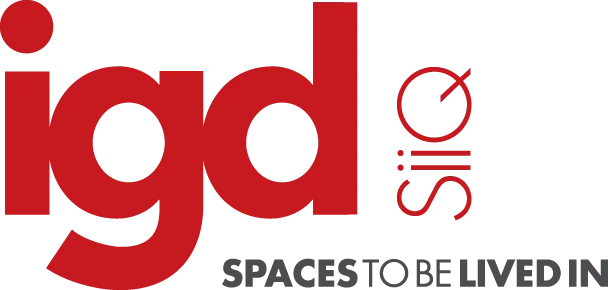Financial obligations: IGD has resources to cover all of 2021

Over the last few months IGD has taken steps to strengthen its financial structure and guarantee coverage of its financial needs through all of 2021. This includes applying for a €36.3 million loan, guaranteed by SACE, which was completed successfully in September: new financial resources arrived mid-October.
The Company’s debt is also still considered investment grade: Fitch confirmed the BBB- rating because of the high rent collection rate which exceeded their initial forecast and the high number of leases renegotiated with tenants.
What elements will influence the rating agencies’ decisions at year-end and when will investors be ready to close the ample discount with which IGD’s stock trades against its NAV?
Andrea Bonvicini, IGD’s Chief Financial Officer and Treasurer provides us with some insight on these topics.
A €36 million SACE loan was granted mid-October. How should we interpret this news?
It’s an important step toward the organic financial sustainability strategy that we shared with the market at the beginning of the lockdown period. This is a government guaranteed loan that IGD was able to access after having satisfied a whole series of conditions. The loan has a maximum duration of six years with a two-year pre-amortization period and was granted at a rate in line with our average cost of debt. As the loan is for a relatively small amount with respect to our stock of debt, we decided to receive it through one bank, Banca MPS, which is already one of our main banking partners.
What goal did you achieve with this loan?
The MPS loan guaranteed by SACE is consistent with the goal to stabilize our Group’s balance sheet/financial structure during what is a delicate time due to the uncertainties about how the pandemic will evolve. During the reporting period, in order to conserve cash and comply with the SACE requisites, we decided to reduce the dividend to €22.5 million, the minimum needed to maintain SIIQ status. We also suspended a few investments in the pipeline, limiting them to around €40 million and renewed €60 million in committed credit lines through 2023.
How will the € 36.3 million obtained from MPS be used?
The new funds, in accordance with the SACE regulations, will be used to cover personnel expense, the investments still in our pipeline and working capital.
“With this last loan we have enough cash to cover all of 2021.”
At this point what do your future debt maturities look like?
We will have €154 million falling due in 2022, followed by a €200 million loan from BNP Paribas maturing in 2023 which we can decide to extinguish in advance. If a window should materialize for the placement of a new bond issue we could, as early as 2022, have the size needed for a new corporate issue.
What is the rating agencies’ view of IGD’s debt today?
All three of the agencies who have rated our debt completed their analyses in light of the overall sector performance. S&P Global Ratings and Moody’s have a very negative view, influenced by the problems encountered by the large Anglo-Saxon malls: they, therefore, projected a heavy drop in sales in the face of high vacancy rates, with further portfolio writedowns in 2021, as well. Both S&P and Moody’s downgraded IGD’s debt, in March and July 2020 respectively, without waiting to verify our actual performance. Both rating agencies recognize that we have a very solid liquidity position, in line with investment grade companies.
And what was the opinion of Fitch Ratings?
Fitch adopted a less pessimistic stance and a more “wait and see” attitude, while distinguishing between the temporary impact and potential structural impact of the new scenario produced by Covid-19.
“As a result of the frequent conversations we had with Fitch beginning mid-May, Fitch was able to verify how the tenant sales of our portfolio are improving continuously.”
Fitch also found that the rent collection rate was higher than their initial forecast and that a large number of leases had already been renegotiated with tenants. This resulted in the confirmation of the investment grade rating BBB- on 1 October. The Negative Rating Watch was removed, while a Negative outlook was assigned due to the uncertainty linked to future developments in the pandemic. Fitch was particularly appreciative of the visibility of IGD’s commercial strategy which only provides for temporary discounts and allows tenants to defer the payment of rent.
“With almost 90% of the retailers back in the shopping centers, deferred payments or temporary discounts were granted which will only impact 2020.”
Which aspects will Fitch Ratings’ year-end rating focus on?
As the payment of different receivables was deferred until 4Q, Fitch will most certainly want to verify the collection rate for FY 2020 and will focus on the Net Debt/EBITDA ratio.
What are the most important levers IGD can use to lower its debt?
Dispose of assets, without a doubt. The €150-200 million that we had originally included in our Business Plan is still the target we will continue to work on even during the current “wait and see” market.
We have seen a few large sector players go the capital increase route…
IGD is following another path, including in light of the penalizing price of the stock in the last few weeks with, moreover, very low volumes. Obviously, we will, however, consider all market options.
“As the stock has been trading at a discount of 70% against its NAV, we are happy that our financial needs are covered through 2021 and we have no need for additional resources.”
What aspects are the investors you have met with recently focused on?
Along with the rest of the management team, I participated in Morgan Stanley’s and Goldman Sach’s two virtual conferences, as well as the STAR Conference organized by the Italian Stock Exchange. I must say that when looking at debt, investors seem to appreciate stable cash follow and the ability to generate operating cash flow that can be used to reduce debt.
When will investors change their view of the sector and, consequently, of your stock?
“I think we will have to wait and see the year-end figures as it will then be possible to verify the actual rate of revenue collection, as well as the impact of Covid-19 on valuations.”
In December we will also be able to verify how lease renewals with tenants are going, which to date have been closed at conditions in line with those of the recent pass. If the overall picture is positive, the current discount against the NAV would not be justified, even if I expect that the “spread” caused by the repercussions of the pandemic will continue to weigh on the stock through the end of 2021.
Thanks and buon lavoro.
Share




